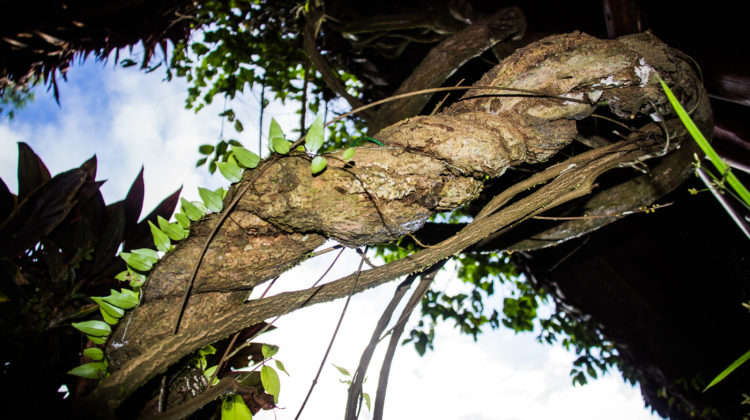
Close up of ayahuasca vine. Photo credit: Apollo/flickr.
On February 2nd, there was a massive controversy in the psychedelics community over a patent for N, N-dimethyltryptamine (DMT) vape pens being granted when a market for them already exists. It raises an issue since the patenter claimed to have ‘invented’ it when that is not the case. In fact, many have used the psychedelic substance for quite some time. But what exactly is DMT?
DMT is a type of entheogen and can be naturally found in various plants, such as the banisteriopsis caapi vine. In its synthetic form, it appears as a white crystalline powder.
DMT provides a hallucinogenic experience that lasts around 20 to 45 minutes. One of its nicknames is the “God Molecule.” As Vice explains, users have chosen this name because it provides an experience they compare to a communion with the divine. Regular users of DMT may even develop beliefs in God or other higher powers. In particular, how they see reality has changed in response to taking DMT.
Traditional Uses Of DMT
In 1931, the Canadian chemist Richard Manske first synthesized DMT. A decade and a half later, another chemist Stephen Szara would make the discovery of its hallucinogenic properties after extracting it and using it himself. At the time, it was believed that hallucinogens played a role in causing schizophrenia.
Due to DMT’s similarity to psychedelics like LSD, it is often used for religious or spiritual purposes. The most popular ways to use DMT is to smoke it with a pipe or to brew it into a drink like ayahuasca. But, as mentioned above, one can also vape it.
However, Native North and South Americans traditionally use it in rituals and as a type of remedy.
According to the Alcohol and Drug Foundation (ADF), ayahuasca is a concoction made by boiling the banisteriopsis caapi vine and leaves of the psychotria viridis shrub. By drinking it, one may experience effects that range from intense visual and auditory hallucinations to feelings of euphoria. It may also cause raises in temperature, blood pressure, and heart rate.
The Cultural Survival Quarterly Magazine goes into more depth on this brew. In South American indigenous tribes, for example, shamans use ayahuasca to transform into animals or elements to explore other worlds or to engage in conflict with other shamans. Among its traditional uses, shamans have also made it a catalyst for spiritual journeys to heal the soul as well as fight off and remove illness from a patient.
Experiencing DMT
In 2020, eLife — a nonprofit research organization — reported on a study of DMT and its effects on brain waves. In the study, researchers gave DMT to healthy participants through an IV. They recorded the participants in two separate sessions with electrodes before and after their use of DMT.
In one session, participants had their eyes closed; in the second session, they underwent visual stimulation with their eyes opened. Using fMRI of the brain, brainstem, and spinal cord, the researchers recorded the participants’ brain waves associated with visual activity.
After the recordings, the researchers found the results of the observation to show rapid changes in the participants’ brain activity shortly after taking DMT. A comparison of the first and second sessions showed that the brain wave activity with eyes closed was the same as regular visual stimulation. This confirmed the participants’ hallucinogenic experiences. Researchers also noted its potential role to reduce symptoms of Alzheimer’s by stimulating serotonin receptors.
Meeting Otherworldly Beings and Machine Elves
In another Frontiers in Psychology study, researchers interviewed 36 experienced DMT users to better understand its effects. Participants brought their own supply of DMT as well as smoking tools (glass pipes, vape pens, and dab rigs). They took dosages ranging from 40 mg to 70 mg.
From the interview of their DMT experiences, researchers found that 94% of them had met otherworldly beings. These ranged from featureless figures, humanoids, and alien-like creatures.
One participant described the encounter with their entity: “a lot of very strange clowns…mechanical entities. Very cartoonistic. And again trying to show me something… It was like a toy …continuously moving and changing shapes and colors… [they would] push them in my face… and I could see every single detail.”
Some even interacted with these beings, and developed a form of understanding and unity with them. A majority of the beings provided positive encounters. Participants of these exchanges noted spiritual healing and the benevolence or curiosity of the entities.
All the interviews in the study, however, shared one commonality: they appeared in some form of augmented reality.
In fact, according to Monster Children, the late Terence McKenna — an ethnobotanist who advocated for the use of psychedelics — described seeing machine elves when using enough DMT. However, his experience is not just one isolated case since many people shared meeting similar beings. This recurring theme of these mechanical elves has raised beliefs that these entities and alternate dimensions are real.
DMT’s prospects
While scientists are currently conducting studies to examine DMT’s medical properties, U.S. officials have considered DMT a schedule I drug without any medical use since the 1970s. However, a 2006 ruling by the Supreme Court has allowed its use for religious ceremonies such as those held by South American tribes.
Some cities have agreed to decriminalize DMT. For example, according to the Law Offices of Omar Figueroa, Oakland and Santa Cruz have allowed the use of different psychedelic plants and mushrooms, including those like ayahuasca that contain DMT.
However, while some communities are decriminalizing the use of certain hallucinogens like DMT, it remains federally illegal. But, scientists are starting to further explore the medicinal use of such substances. If studies do prove DMT has pharmaceutical use, it may pave the road to changes in federal and state laws against it.



Leave a Reply